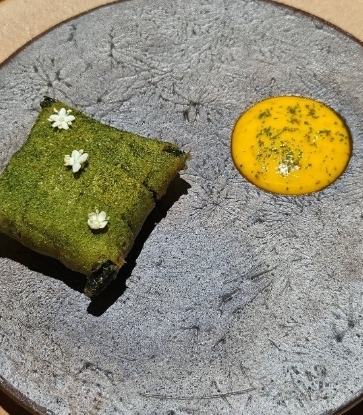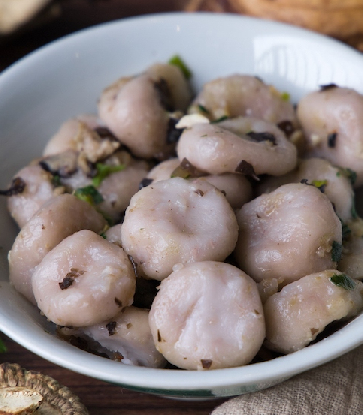Ceki is fronted by Esther Tan, whose husband, Francis Tee, does all the cooking based upon heirloom Penang-Nyonya recipes passed down by Tan's grandmother. The restaurant is the result of a woman's dream coming to fruition — a dream to recreate fond childhood memories of her food-loving, card-playing Nyonya grandmother.
For the amiable husband-and-wife co-owners, Ceki was the culmination of their enduring love for Nyonya food, in an atmospheric setting that is the very embodiment of a Peranakan family home of yore. Stepping over the threshold of Ceki, one feels like being transported through the portals of time, and into the lush drawing room of a Peranakan matriarch, filled with family heirloom furniture, Nyonya-ware, and artworks. There is a brace of Swiss voile kebayas that belonged to Tan's grandmother, carefully framed and proudly displayed in one corner. The Straits-Chinese Peranakan style of interior décor is closer to a Malay one, with a surfeit of carved wooden elements, and dim mood lighting, in contrast to the Chinese preference for bright lights and functional décor.

Before the genial couple decided to open Ceki in November 2018, Tan was a material planner for a manufacturing company, whilst Tee was a veteran in the tour industry.
As a young girl, Tan used to accompany her Peranakan-Nyonya grandmother to “ceki” card game-playing sessions. “Ceki” is a popular past-time amongst older Nyonyas in Penang, Malacca, and Singapore. It’s the Peranakan equivalent of the Western bridge: a four-player card game. Nyonyas would take turns hosting a card game evening, which also entailed providing refreshments to the guests. And, as a matter of pride, impressing one’s guests with one’s culinary offerings was of utmost importance.
Tan's earliest taste memories stemmed from her food experiences at her grandmother’s card-playing-cum-gourmet sessions — hence, the naming of her restaurant after the card game itself. She loved everything she tried, but her favourites are asam pedas, sambal goreng , and pengat — all of which are featured prominently at Ceki.

As for Tee, who had worked as a tour guide for over three decades, his biggest challenge had always been to find really good Nyonya restaurants to satisfy his finicky guests, especially Singaporeans who found Penang restaurants often used inferior quality produce. So, he decided he will do Nyonya cooking himself — using the freshest, best quality ingredients there are.
Ceki today, with Tee’s meticulous cooking and Tan's old world Nyonya hospitality, brings Penang-Nyonya dining back to its traditional roots: carefully concocted, elaborately constructed dishes, served with care and elegance.
The restaurant’s repertoire of must-try dishes includes their tau yu bak (soy-braised pork belly), sambal goreng (prawns & cashews in coconut crème), jiu hu char (braised jicama with dried cuttlefish), and assam hae (tamarind-marinated prawns), plus Ceki’s trio of Nyonya desserts: pengat (sweet potatoes & taro in coconut milk) , bee koh moy (black glutinous rice with coconut crème), and gandum (sweet wheat porridge with coconut milk). Tee's use of the freshest ingredients really made the difference.

However, it is Ceki’s asam pedas that is labelled a a must-order, an excellent rendition that will leave one craving for more. Tee's full-bodied version is perfectly-spiced — richer and thicker than the usual lighter, soupier versions one finds in Penang.
It also happens to be Ceki’s priciest item on the menu, as Tee refuses to compromise on quality and only uses the best cuts of fresh grouper, his fish of choice. His asam pedas is redolent of fresh herbs and spices. The perfectly cooked fish is paired with blanched okra and tomato wedges, then topped with fresh mint leaves and a confetti of finely-chopped pink torch ginger. Here's the recipe below!
Ceki's Asam Pedas Fish
Ingredients for the Spice Paste (rempah)
- 20 dried chillies, soaked in hot water till soft, then drained
- 4-6 fresh chillies, sliced
- 25-30 small red onions/shallots, peeled and sliced
- 5-6 cloves garlic, bashed & peeled
- 3 stalks lemongrass, sliced; discard the greenish parts
- Thumb-sized fresh turmeric, peeled and sliced
- 2 Tablespoons belacan (fermented shrimp paste), toasted and pounded
Ingredients for the Stock
- 3-4 Tablespoons tamarind pulp (asam jawa)
- 4 cups water
- Salt & sugar to taste
Ingredients for the Garnish
- 2 stalks torch ginger flower (bunga kantan), finely-chopped; set aside 1 teaspoon for garnish at the end
- 4-5 ladyfingers or okra, blanched
- 1 sprig fresh mint leaves
Other Ingredients
- Peanut or corn oil, for sautéing the spice paste
- 1 large black pomfret, or roughly 800 gm, of white-fleshed fish (threadfin) or stingray
- 2 tomatoes, cut into wedges
- Salt & sugar to taste
Procedure
1. Blend all the spice paste ingredients together (if you are feeling traditional, use a mortar and pestle).
2. Mix the tamarind pulp with the water, strain and set aside.
3. Gently sauté the spice paste over medium flame in a cup of oil. Make sure the spice paste is not over-browned or burnt. The process takes about 15 minutes and is ready once the oil separates from the paste, and the sautéed mixture is aromatic.
4. Pour in the strained tamarind water and bring to a boil. Lower heat and simmer for 10-15 minutes.
5. Add the fish, tomatoes, and torch ginger flower. Gently simmer till the fish is just cooked, about 2 minutes. Do not overcook, else the fish will be overly-dry.
6. To serve, garnish with blanched ladyfingers, mint leaves, and extra torch ginger flower.
Today, Ceki proudly stands as an embodiment of a young girl’s nostalgic reminiscences of her grandmother, bringing her food memories to life so that everyone can get to savour her beloved dishes from a bygone era. Aren’t we the lucky ones!


















